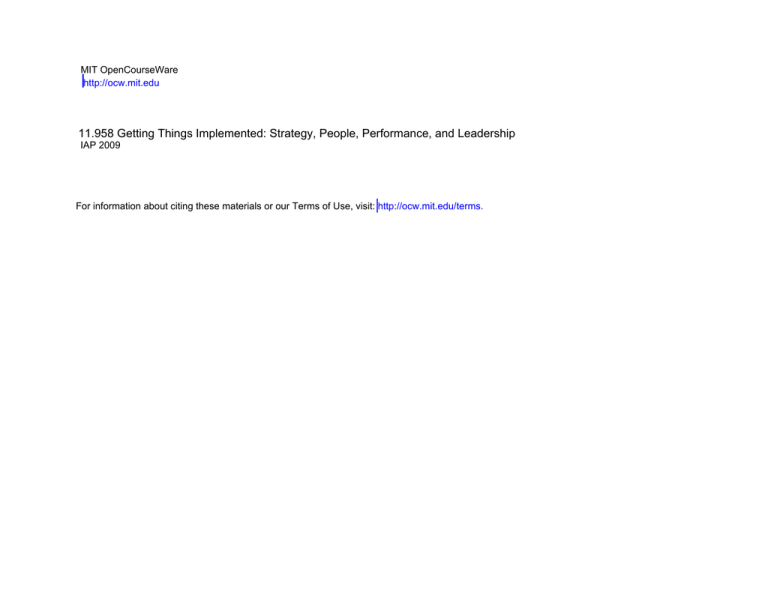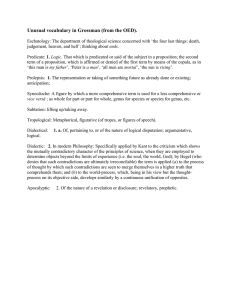11.958 Getting Things Implemented: Strategy, People, Performance, and Leadership MIT OpenCourseWare
advertisement

MIT OpenCourseWare http://ocw.mit.edu 11.958 Getting Things Implemented: Strategy, People, Performance, and Leadership IAP 2009 For information about citing these materials or our Terms of Use, visit: http://ocw.mit.edu/terms. Developing and Changing Organizational Strategy 11.958 Getting Things Implemented January 2009 DAY 2 NOTES Getting Things Implemented Slide 1 Outline Models of strategy (strategic triangle, competitive strategy): MIPESA Strategy as alignment to create public value Strategy as serving customers in segments Analyzing implications: for governance, staffing, relevance, service geography, etc. Analyzing alignment changes over the life-cycle of an organization: CARE USA and its Mission in Thailand Ways to shift capacity to meet new demands Defining (and preserving) the “core,” stimulating progress: Promising targets Getting Things Implemented Slide 2 The strategic triangle MISSION (compelling value proposition) •Viable organizational structure (division of labor, lines of authority) •Smart operational processes •Healthy, supportive internal culture ENVIRONMENT Task (operational context for work) Authorizing (context for winning support) Getting Things Implemented CAPACITY •Well-applied technology •Reputation or brand •Valuable networks Slide 3 Notes on triangle The overall challenge (and opportunity) is a powerful alignment: Lining up the valuecreating idea with what the environment will support and what the organization (or team or alliance) is actually capable of producing. Capacity gets converted into value through specific activities (products), such as filing legal injunctions against eviction, planning landscapes, helping kids get vaccinated, etc. Mis-alignment can have one or more sources: The environment’s demands or opportunities shift, capacity erodes, etc. Getting Things Implemented Slide 4 Major risks MISSION STICKINESS (“with blinders on”): an overly rigid attachment to a traditional value proposition and/or recipe for capably delivering on it. MISSION DRIFT (“yeah, we do that …”): rudderless operation, perhaps pursuing whatever the funders want this season. Getting Things Implemented Slide 5 Why does MIPESA need a strategy? It has never had a formal one. The old world was brutal, if simple: value proposition was “promote secure tenure,” tactics were limited, clients were many and grateful, target was oppressive government. The new world is not, and it’s challenging: law against squatting is repealed, attention shifts to broader service and community development needs, multiple competitors appear, donors pressure for change. Getting Things Implemented Slide 6 Some options for MIPESA Serve the “old” definition of client (someone who needs an advocate) with new “products” (services). Serve a new definition of client (a recipient of services provided by some other party) with the old product (advocacy, making claims). Much less likely: Serve new definitions of client with new products (?). This abandons MIPESA’s community and “line of work.” Getting Things Implemented Slide 7 Possible implications New leadership: Is Ndlovu a clockbuilder? Is he the right manager for the next stage? New governance: An engaged board that actually directs, not just a “rubber stamp” for a strong CEO. See Leadership as Governance book. New operating capacity: Service provision is a very different value-creating activity. New funder-clients or new relationships with “old” ones. New accountability expectations, new value propositions for new partners? Getting Things Implemented Slide 8 Options for shifting capacity to align with new value proposition (mission) Re-focus elements of the capacity we have to serve new purposes. Eliminate capacity we don’t need “in house” any more. Got a back-up plan in case we need it down the line (Buy it? Partner?) Add new capacity we need in house. These decisions, too, need to be driven by a clear case for what the “clock” needs to do next. Getting Things Implemented Slide 9 Organizations and their environments Several things are special about nongovernmental organizations vis-à-vis their environments: Expectations: These are even murkier than they are for public sector organizations. Signals: Less clear than for for-profit companies (which have price, revenues, market share to constantly signal to them what the environment supports) Capacity: The authorizing environment, funders in particular, tend to starve it, not build it. They focus on programs/products to meet categorical needs—time telling, not clock building. Getting Things Implemented Slide 10 Summary: Lessons Times change, great products come and go: So build the clock (organization) as a platform that learns, adapts, adds value over the long haul. Great leaders also come and go. There’s no substitute for organized capacity, beyond any charismatic, smart, or otherwise talented individual. Getting Things Implemented Slide 11 Case B: CARE USA and Thailand CARE begins as “Cooperative for American Remittances to Europe.” It’s operating model is focused on collecting, storing, shipping, and distributing discrete packets of aid, not doing “development.” It quickly acquires a reputation for innovative operations, grows into 3rd world relief, sets targets for time-limited “missions” that leave countries once key needs seem to be met. Then come demands for development assistance, more bottom-up decisionmaking, “indigenization,” flexible ideas of development need, etc. The case of CARE USA in Thailand is a window on larger dilemmas, as well as a significant opportunity to innovate—but how? … Getting Things Implemented Slide 12 Strategic options Status quo: Usually the virtues of this option include risk avoidance and/or continued value creation of some kind. Shut down and leave: Consistent with precedent, misses opportunities, surrenders presence and leverage in the region. “Hand off” to local NGO: Indigenizes but poses other risks, may leave big gaps in value created or potential innovations (HIV/AIDS etc.). Dual status NGO (decentralized “CARE”): Some of the best of other options, represents an intermediate step, chance to take calculated risk, produce learning. Getting Things Implemented Slide 13 Considerations from decision analysis Avoid taking decision until you have to: Info is precious, you might learn something vital, make plans to learn it. All else being equal, favor options that are reversible and leave open more options/pathways over options that close off pathways or are less reversible. “Dual status” is the former, “shut down” the latter, for example (could lead to valuable learning and still leave open the shut down and hand off options). Getting Things Implemented Slide 14 Preserve the core, stimulate progress What is the “CORE”? Usually, deeply held values (commitment to excellence and/or innovation, taking on the tasks that no other organization will, etc.) or competencies or a bit of both. They are many ways to act on what’s core. That’s the point of stimulating progress … What are the top targets for “PROGRESS”? Usually, policies and practices. Loyalists may confuse either for deep values, but policies and practices exist to advance values and interests. The former are not valuable in and of themselves, even though people get attached to them. For example, the “no nationals as country director” policy, which may have outlived its usefulness. Getting Things Implemented Slide 15

